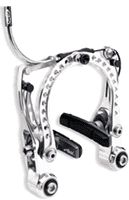
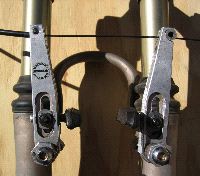
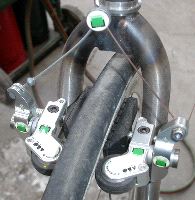
tech sheets (720kb)
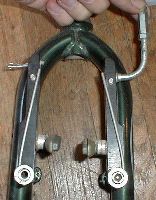
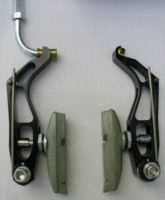
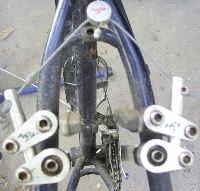
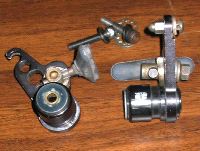
 |
avid - arch supreme | yeah, i know. they're not obscure by any stretch of the imagination, and they're the first brake in the list, but thats only because of the alphabet. they're here not because they're so odd, but because they're mechanically interesting, and somewhat deviant from the standard long-arm canti/v-brake design. a different approach to the parallel-push idea behind some of the high-end shimano v-brakes, and a better one, in some people's opinion. |
 |
brooklyn machine works - snot rocket | very basic long-arm canti, but the part that started the bmw business... |
 |
brovedani anti-loc cantilevers
tech sheets (720kb) |
crazy italians. a fairly standard-looking low-profile cantilever, with one exception... the roller in front of the brake pad, as it contacts the rim, drives a cam which pulses the actual brake pad in and out slightly during braking. voila! anti-lock brakes for your mountain bike. do they work? i dont know. would i be a little nervous to try them? yes. |
 |
marinovative - cheap trick | ok, not all that different than a standard long-arm cantilever - but crazy light, homebuilt, and quite effective. i like them, so they're here. nevermind that they were one of the first "linear-pull" cantilevers that started everything towards v-brakes... |
 |
mcmahon racing components - batwing | very similar in basic design to a lot of linear-pull brakes, but way funky on the design end - the batwing is to the linear decelerator as the widget is to the switchback... well... sort of... |
 |
onza - h.o.? | i forget the name of these little buggers. while theyre not all that unique on a certain level, the neat thing about them is that they allow enough adjustability to switch back and forth from 26" to 700c wheels on the same set of canti studs. that's cool in my book. |
 |
scott/pederson - se (self-energizing) cantilevers | these had a very brief moment in the sun sometime in the late 80's. definitely more powerful than standard cantilevers, but i personally was never all that impressed by them for one reason or the other. the brake arms were mounted on a helical spline. as the brake pads touched the rim, they were drawn forward by the rim rotation, and squeezed tighter onto the rim by the helical spline. due to the spline direction being crucially linked to the direction of wheel rotation as related to the position of the brake mounts, they came in front- or rear-specific versions. mounted on the wrong wheel, the spline would reduce pad pressure, rather than increase it. some people had concerns about non-linear braking action, and the possibility of the brakes "grabbing" the rim and not releasing - john forester, i beleive, did a writeup detailing how the se brake would lock up upon application when used with some suspension forks. |
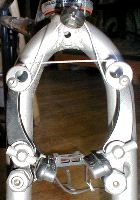
2nd generation 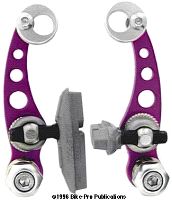
"micro switchback" tech sheets (720kb) |
interloc racing design - switchback | interloc's first cantilevers. quite effective, when set up properly (a common thread with all ird brakes). you can't quite make it out in the illustration, but the straddle cable is a continuous band that loops around the 2 rollers (which are pinned off-center, adding a bit of cam-type action). in contrast to the marinovative decelerators below, the brake cable pulls the bottom section of the loop of wire, which has been brought up and over the top of the loop, creating a sort of 3-part figure 8. |
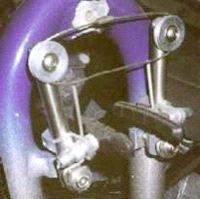 |
marinovative - decelerator | a similar design to the ird switchback, but with non-eccentric pulleys. this one is set up wrong - the cable hanger should pull on the bottom section of the straddle wire loop.. |
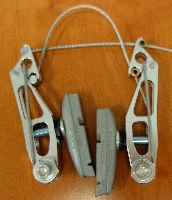 |
mcmahon racing components - linear decelerator |
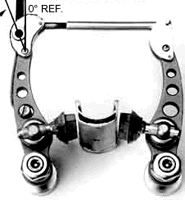
2nd generation 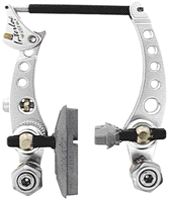
3rd generation |
interloc racing design - widget | these evolved as a solution to running cantilever brakes on rear-suspension swingarms - ird took the Switchback arms, and did a little redesigning, and voila! the widget. scorchingly effective, when set up right. 3 versions exist, from various stages in it's evolution - 2 very similar earlier variants, and the 3rd generation version which was the stock rear brake on some trek full-sus bike. |
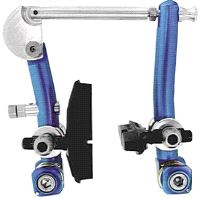
crosstop I 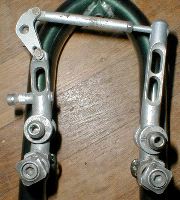
crosstop III tech sheets (752kb) |
paul components - crosstop I, II, II, MC | the most common variant of the widget design, and a fairly adequate version - i tend to think the widget works a bit better, but that's me. i had problems with the cable pinch bolt (2mm allen bolt? argh! what were you thinking?!?!), and the "dealie" on my crosstop III's. |
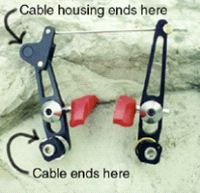
1st generation 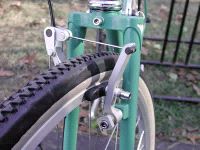
2nd generation |
strange - strange brake | another variant of the Widget straight-bar linkage design, but with the threaded bar replaced (simply and logically!) with a spoke and nipple. Ingenious! |
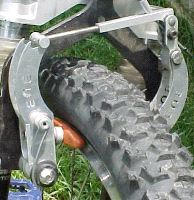 |
wasatch cycle works - clamp | a similar design to the widget, but instead of pivoting a cam on the left brake arm, pulling the cable closes the hinge on the right arm, which forces the brake arms together. the cable housing stop is in the crossbar itself, and the pinch bolt is in the lower arm of the hinge. another very effective mechanical advantage type of brake - one that looks quite clunky, but seems to work quite well. |